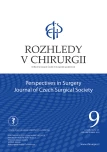Partial resection of native and prosthetic arteriovenous fistula as a treatment of late infections complications – series of case reports
Authors:
A. Svobodová 1,2; M. Slavíková 1; R. Lainková 1,2; M. Špaček 1,2; T. Grus 1,2; J. Lindner 1,2
Authors‘ workplace:
II. chirurgická klinika kardiovaskulární chirurgie, 1. lékařská fakulta, Univerzita Karlova a Všeobecná fakultní nemocnice v Praze
1; 1. lékařská fakulta Univerzity Karlovy v Praze
2
Published in:
Rozhl. Chir., 2022, roč. 101, č. 9, s. 460-464.
Category:
Case Report
doi:
https://doi.org/10.33699/PIS.2022.101.9.460–464
Overview
Introduction: Infection of arteriovenous fistula (AV) used for hemodialysis (HD) is associated with massive bleeding, sepsis development, formation of metastatic infectious foci, and a high risk of AV loss. Urgent management of an infected AV is crucial for successful treatment and AV salvage.
Case reports: We present the use of partial resection as a successful method of dealing with late AV infection in two cases. In case 1, the resection was performed due to an infection of the native arteriovenous fistula (AVF) with two defects above the drainage vein aneurysms. In case 2, partial resection and replacement of the prosthetic arteriovenous fistula (AVG) were done due to an infection of HD puncture site. The AVs remained patent in both cases, with no further signs of infection postoperatively and, most importantly, without the need to use a temporary HD catheter.
Conclusion: The establishment of a new AV is limited by the quality of the venous and arterial systems. All surgical, interventional and non-surgical means should be used to safely maintain the created AV patent. Provided that the requirements of an early indication are met, partial resection of the AV is the method of choice for AV infections and allows us to avoid using a permanent dialysis catheter in our patients.
Keywords:
infection – hemodialysis – arteriovenous fistula – partial resection
Sources
1. Woo K, Dillavou E, Berns J, et al. Arteriovenous fistula creation for hemodialysis and its complications. UpToDate 2021, Oct 27.
2. Lok CE, Huber TS, Lee T, et al. KDOQI clinical practice guideline for vascular access: 2019 update. Am J Kidney Dis. 2020;75:S1.
3. Rychlík I, Lopot F, Francová. Statistická ročenka dialyzační léčby v České republice v roce 2020 [2022-01-20]. Available at: www.nefrol.cz/odbornici/dialyzacni- statistika.
4. Attia MI, Atta EM, Elheneidy MA, et al. Salvage of infected autogenous arteriovenous fistulas, is it possible? The Journal of Vascular Access February 2022. doi:10.1177/11297298221080080.
5. Schmidli J, Widmer MK, Mohaupt M, et al. Vascular access: 2018 clinical practice guidelines of the European Society for Vascular Surgery. European Journal of Vascular and Endovascular Surgery 2018;6:757−818. doi:10.1016/j. ejvs.2018.02.001.
6. Gallieni M, Hollenbeck M, Inston N, et al. Clinical practice guideline on peri- and postoperative care of arteriovenous fistulas and grafts for haemodialysis in adults. Nephrology Dialysis Transplantation 2019;34 (Suppl 2). doi:10.1093/ndt/ gfz072.
7. Stegmayr B, Willems Ch, Growth T, et al. Arteriovenous access in hemodialysis: A multidisciplinary perspective for future solutions. Int J Artif Organs 2021 Jan;44(1):3−16. doi:10.1177/0391398820922231.
8. Hartinger JM, Šíma M, Hronová K, et al. Vancomycin pharmacokinetics in patients treated with intermittent haemodialysis based on therapeutic drug monitoring. J Chemother. 2022 May;34(3):149156. doi:1 0.1080/1120009X.2021.1979747.
Labels
Surgery Orthopaedics Trauma surgeryArticle was published in
Perspectives in Surgery

2022 Issue 9
- Metamizole at a Glance and in Practice – Effective Non-Opioid Analgesic for All Ages
- Safety and Tolerance of Metamizole in Postoperative Analgesia in Children
- Possibilities of Using Metamizole in the Treatment of Acute Primary Headaches
- The Importance of Hydration in Wound Healing
Most read in this issue
- Surgery of iatrogenic bile duct injuries
- Zhoubné nádory mimojaterních žlučových cest
- Allen-Masters syndrome as a cause of status ileus – case report
- Surgery of extrahepatic bile duct cancer – current evidence and recommendations
